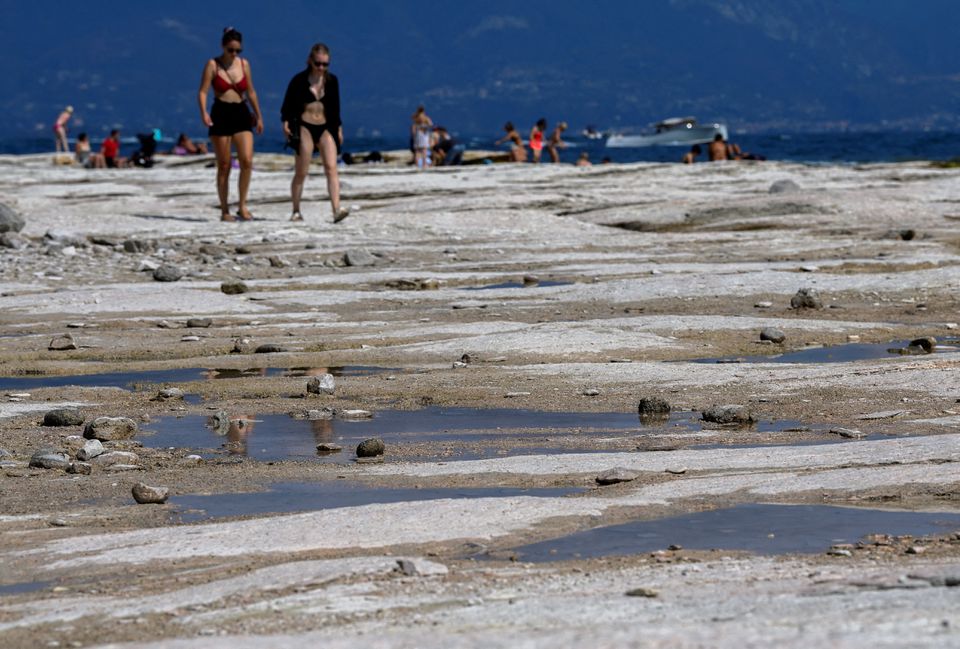More Than Half The World’s Lakes Drying Up, Says Study
May 20, 2023 | Pratirodh Bureau
FILE PHOTO: People walk as underwater rocks emerge from the water of Lake Garda after northern Italy experienced the worst drought in 70 years in Sirmione, Italy on August 16, 2022 (Reuters)
Source: DW
Researchers of a new study say global warming and human consumption are causing the world’s lakes to lose water. Over half of the world’s lakes have shrunk, according to a new study published on Thursday.
An international research team published their findings in the journal Science and found global warming and human activity to be the chief culprits.
Natural lakes and reservoirs contain around 87% of the Earth’s freshwater —only about 3% of Earth’s water is fresh.
The report highlighted the need for water management solutions.
What were some of the findings?
According to the research, led by hydrologist Fangfang Yao of the University of Colorado, the world’s large lakes and reservoirs had shrunk since the early 1990s.
The team of experts said some of the world’s critical freshwater sources had lost water at a cumulative rate of around 22 gigatonnes per year for nearly three decades.
“More than half of the decline is primarily attributable to human consumption or indirect human signals through climate warming,” said Yao, who pointed out that warming contributed “the larger share of that.”
Researchers also found that changes in rainfall and run-off, sedimentation, and rising temperatures had caused global reductions in lake levels.
Almost 30 years of satellite data used
The team measured the change in water levels in nearly 2,000 of the world’s lakes and other water bodies and based the report on satellite data collected between 1992 and 2020.
In the United States, Lake Mead lost two-thirds of its water during the 28-year period.
The study also found that unsustainable human use dried up lakes, including the Aral Sea in Central Asia and the Dead Sea in the Middle East.
Lakes in Afghanistan, Egypt and Mongolia were hit by rising temperatures, which led to increased rates of surface evaporation.
Scientists said it is necessary to limit global warming to 1.5 degrees Celsius (2.7 degrees Fahrenheit) to avoid the consequences of climate change. The world is currently warming at a rate of around 1.1C (1.9F).
Meanwhile, the WMO says the combined effect of El Nino and greenhouse gases will cause temperatures to soar and has warned: “We need to be prepared.”The next five years are expected to be the warmest period on record, the UN’s World Meteorological Organization (WMO) has warned.
“There is a 98-percent likelihood that at least one of the next five years, and the five-year period as a whole, will be the warmest on record,” the WMO said.
‘We need to be prepared’
The WMO said that greenhouse gases and the combined effect of El Nino — a naturally occurring weather phenomenon — would cause temperatures to soar from 2023 to 2027.
“A warming El Nino is expected to develop in the coming months and this will combine with human-induced climate change to push global temperatures into uncharted territory,” WMO Secretary-General Petteri Taalas said.
El Nino and La Nina are climate patterns that foster extreme weather in many regions of the world.
Typically El Nino drives up average global temperatures, while La Nina has a cooling effect.
“WMO is sounding the alarm that we will breach the 1.5C level on a temporary basis with increasing frequency”, Taalas cautioned and said that there would be “far-reaching repercussions” when it came to health, food security, water management and the environment.
“We need to be prepared,” the professor warned.
The new report was released ahead of the World Meteorological Congress — taking place from 22 May to 2 June — which will discuss how to strengthen weather and climate services to support climate change adaptation.
WMO predictions
According to the WMO, the annual mean global near-surface temperature for each year between 2023 and 2027 is predicted to be between 1.1°C and 1.8°C higher than the 1850-1900 average — which is regarded as a baseline due to it being the period before greenhouse gases from human activities.
Arctic warming was predicted to be more than three times larger than the global average over the next five northern hemisphere winters.
It was predicted there would be increased rainfall in the Sahel, northern Europe, Alaska and northern Siberia, while the opposite would be seen in the Amazon and parts of Australia.
The global mean temperature in 2022 was 1.15C above the 1850-1900 average.
The hottest eight years ever recorded were all between 2015 and 2022, with 2016 the warmest according to the WMO.
